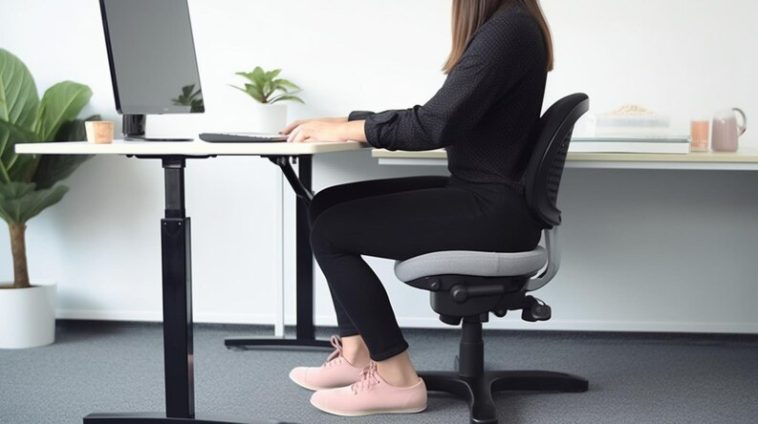The office chair, an essential piece of furniture in workplaces around the world, has undergone a remarkable evolution over the years.
From the classic designs of the past to the modern ergonomic marvels of today, the evolution of office chairs reflects not only changes in design and technology but also shifts in our understanding of comfort, productivity, and well-being in the workplace.
Part I: Classic Office Chairs
Classic office chairs, known for their timeless elegance and traditional craftsmanship, often evoked images of leather, wood, and hand-carved details. These chairs, typically associated with the stately, executive office, prioritized aesthetics and craftsmanship over ergonomic features.
One iconic classic design is the Chesterfield chair, a symbol of luxury and sophistication. With its deep button-tufted leather upholstery and elegantly scrolled arms, it exuded an air of opulence that was synonymous with traditional office settings.
However, these classic chairs, while visually appealing, were not designed for the long hours of computer-based work that characterize modern office environments. They often lacked the lumbar support and adjustability needed to maintain comfort during extended periods of sitting. As a result, employees often find themselves dealing with discomfort, fatigue, and even health issues stemming from poor posture.
Part II: The Transition to Ergonomic Chairs
The 20th century brought significant changes to office chair design as a response to the growing demands of office workers. Ergonomics, a field dedicated to optimizing workspaces for human use, became the guiding principle in office chair design.
Chairs were now engineered to promote comfort and productivity. One of the first significant developments in ergonomic office chairs was the introduction of the swivel chair. This innovation allowed users to move freely and access different parts of their workspace without straining or standing up.
As we moved further into the 20th century, Herman Miller’s Aeron Chair became a groundbreaking symbol of modern office ergonomics. It featured a unique, adaptable design that provided support to the user’s body, particularly the lumbar region.
Its breathable mesh material and flexible frame allowed for better air circulation, addressing the issue of heat buildup that often occurred in classic leather chairs.
The transition to ergonomic chairs marked a significant shift in workplace culture. Employers and designers recognize the importance of the well-being and productivity of their employees.
These chairs were designed not only to accommodate different body types but also to reduce the risk of work-related injuries, such as back pain and carpal tunnel syndrome.
Part III: Modern Office Chair Innovations
In the 21st century, office chair design continued to evolve with advancements in materials, technology, and a greater emphasis on sustainability. Modern office chairs are characterized by a fusion of form and function, incorporating cutting-edge materials and adjustability to meet the diverse needs of today’s workforce.
The use of mesh, a lightweight and breathable material, has become prevalent in modern office chairs. Mesh chairs offer excellent support and ventilation, making them a popular choice for contemporary workplaces. They have the advantage of conforming to the user’s body shape while maintaining an airy, comfortable feel, even during long working hours.
Furthermore, adjustability has reached new heights with modern chairs. Many contemporary designs feature adjustable armrests, lumbar support, and seat height, giving users full control over their sitting experience. This adaptability is crucial in accommodating a diverse workforce with varying body types and preferences.
One of the most significant innovations in recent years is the integration of technology into office chairs. Some models come equipped with Bluetooth connectivity, enabling users to control chair settings through smartphone apps. This level of personalization allows employees to fine-tune their seating for optimum comfort and productivity. Additionally, some chairs include built-in heating and cooling features to ensure a comfortable working environment in all seasons.
Part IV: Sustainability and Office Chairs
In the age of environmental consciousness, sustainability has become a key consideration in office chair design. Manufacturers are increasingly using recycled and eco-friendly materials to reduce their carbon footprint. Additionally, many modern office chairs are designed with longevity in mind, with replaceable parts that extend the chair’s lifespan and reduce waste.
Another aspect of sustainability is the focus on reducing the energy consumption associated with chair production. Some manufacturers are adopting more energy-efficient manufacturing processes and using sustainable practices in their supply chains.
If you are looking for office chairs in Chennai, Kochi and other cities, be sure to choose sustainable office chairs to reduce your carbon footprint.
Furthermore, sustainable office chair design extends beyond just the materials used. Many manufacturers are also prioritizing ergonomic design principles to enhance user comfort and well-being.
By crafting chairs that promote proper posture and provide ample support, these designs contribute to a healthier and more productive work environment.
Additionally, some sustainable office chairs are now equipped with innovative features like adjustable lumbar support, seat depth, and armrest height, allowing users to customize their seating experience for maximum comfort.
This not only fosters employee satisfaction but also reduces the likelihood of work-related injuries, further aligning with the principles of sustainability and well-being in the workplace.
When selecting office chair in Bangalore, Kochi, or any other city, considering these ergonomic features alongside sustainable materials can lead to a choice that benefits both your employees and the environment.
Part V: The Future of Office Chairs
As we look to the future, the evolution of office chairs will likely continue, driven by advances in materials, technology, and our understanding of ergonomics. One possible direction is the integration of health-monitoring features into office chairs, allowing users to track their posture and vital signs in real time.
These chairs could provide feedback to encourage better sitting habits, ultimately promoting better health and well-being in the workplace.
Furthermore, office chairs may become more adaptable to different work settings, such as standing desks and open-plan offices. This adaptability will cater to the evolving nature of work, which increasingly involves flexible arrangements and remote working.
Additionally, the aesthetics of office chairs are likely to undergo significant transformations. Designers are expected to prioritize not only functionality but also a sleek and modern appearance that complements contemporary office spaces. This could involve the use of innovative materials and minimalist designs that seamlessly blend with various office décors. Moreover, customization options may become more prevalent, allowing users to personalize their chairs for both comfort and style.
Furthermore, sustainability will remain a driving force in the future of office chair design. Manufacturers will continue to explore new eco-friendly materials and production methods, aiming to further reduce their environmental impact.
The integration of circular design principles, where chairs are designed with end-of-life recycling in mind, will become more common. This shift towards a circular economy model will not only minimize waste but also contribute to a more sustainable and responsible approach to office furniture production.
As we move forward, selecting office chairs that embody these future-oriented principles will not only enhance the work environment but also demonstrate a commitment to a more sustainable and forward-thinking workplace culture.
Conclusion
The evolution of office chairs from classic designs to modern ergonomic marvels represents a significant shift in our understanding of the workplace. While classic chairs focus on aesthetics and traditional craftsmanship, modern designs prioritize comfort, productivity, and well-being.
Today’s office chairs are more adjustable, breathable, and technologically advanced, catering to the diverse needs of a changing workforce.
As the workplace continues to evolve, office chairs will adapt to meet new challenges and opportunities.
They will likely incorporate even more advanced materials, sustainable practices, and health-monitoring features to promote a healthier and more productive work environment. The future of office chairs is bright, with the promise of further enhancing the way we work and interact with our surroundings.
Whether you’re located in Kochi or Calicut, it’s crucial to prioritize finding the perfect office chair to establish a productive and comfortable workspace.
Therefore, invest time in thoroughly exploring the available options in your local area, whether it’s office chairs in Kochi or Calicut. This way, you can be confident that you’re making a well-informed choice that not only meets your requirements but also complements the style of your home office.




